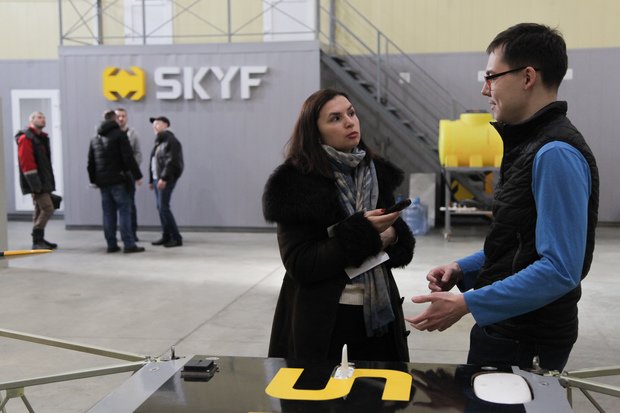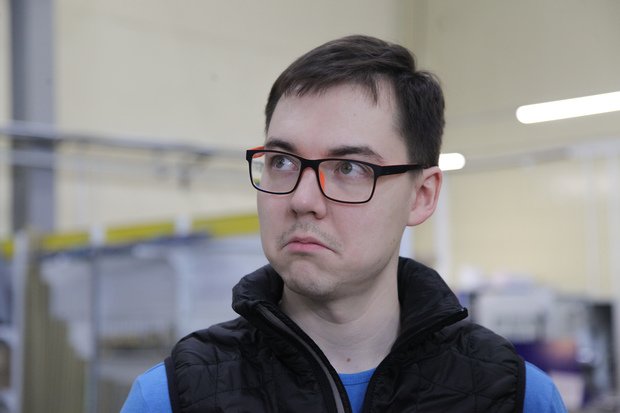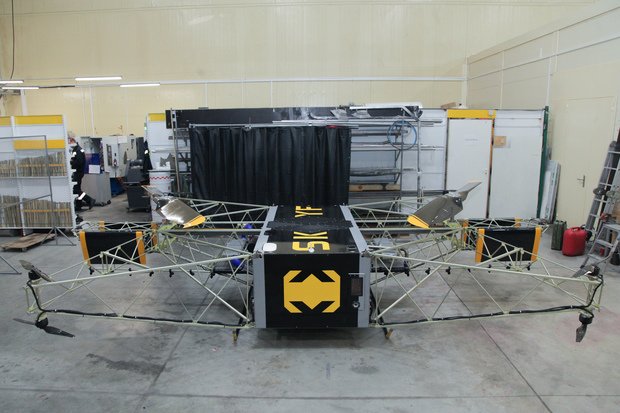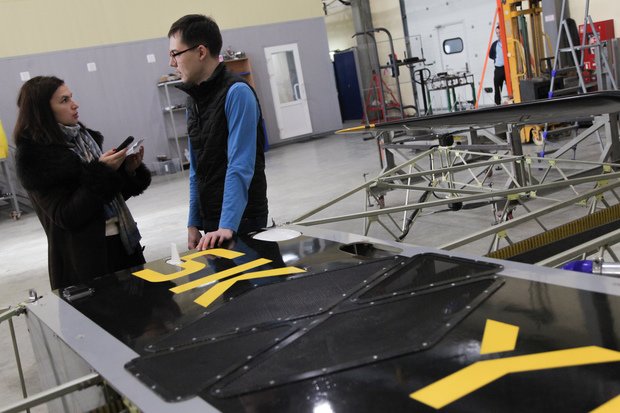''If nobody interferes, the Russian market of unmanned vehicles will be unrecognisable in 10 years''
Founder of Aviasolutions Design Bureau Dmitry Arsentyev about the creation of SKYF, the independence of his production from Russia and the opportunities cargo drones give us
SKYF cargo drone created in Tatarstan is able to occupy a free niche in the world drone market. Now only Mi-8 helicopter is its rival, whose use is much more expensive. The drone's creators claim they will be ready to launch large-scale production in a year, which will allow to pay back all investments in the project for 1-2 years. In an interview with Realnoe Vremya, founder of Aviasolutions Design Bureau Dmitry Arsentyev told how the SKYF cargo drone was created and new spheres of application of unmanned vehicles.
''We worked in a semi-closed regime during the first years''
Dmitry, you're a programmer by trade, you graduated from Moscow State University. Why did you decide to work in Kazan?
I studied programming at MSU first but didn't finish my studies. Then I entered the Higher School of Economics in Nizhny Novgorod. It's when I had my first IT projects. I went back to my native Cheboksary where we dealt with an IT project, sold it across Russia. An idea of a flying bike was born in Cheboksary. When we began working on it, we didn't need a lot of specialists. I studied aviation, did calculations. The city didn't restrict me. But when the project became really attractive for investing, it required rapid development, and the search for new staff appeared on the agenda, we had to move to Kazan, to the aviation capital. Here we opened a design bureau.
Did you immediately choose Khimgrad?
Yes, we immediately chose Khimgard because it is a closed territory with good infrastructure. It was important for us, as we worked in a semi-closed regime during the first years. We didn't want rivals to know about us at an early stage.
Do you still plan to create a flying bike?
No, we realised it is another level of unmanned vehicles, different requirements for people's safety. We also underestimated the value of our unmanned vehicles at the first stage. We thought some $1,5-2 million would be enough to complete the project. However, about $10m have been invested in it now, and the stage of R&D and tests haven't finished yet. We've almost reached large-scale production. Nevertheless, it hasn't finished. Creating an unmanned vehicle to transport people will require hundreds of millions of dollars. It's an unbearable burden for a company that begins its journey. It's a level of Boeing and Airbus. They have prototypes of unmanned taxis, but even they start testing a vehicle without a passenger.

As the vehicle is unmanned, it's able to provide high precision of land cultivation. Agricultural producers don't like not because of the price but because it spreads chemicals inaccurately. The quality of spreading chemicals is more important than the price
Oil companies were interested in the drone
What's the price of the SKYF drone for agriculture?
Pollination of one hectare by our drone will cost 300 rubles. To compare, the job of aviation equipment in the Russian Federation is about 500 rubles, ground equipment is 200 rubles. Our prices are in the middle. But as the vehicle is unmanned, it's able to provide high precision of land cultivation. Agricultural producers don't like aviation not because of the price but because it spreads chemicals inaccurately. The quality of spreading chemicals is more important than the price.
The accuracy of the flight is important: if a plane flies a bit lower or higher than its course, spreading will be uneven, which will affect the yield. And people usually turn to aviation when locusts attacked, and the question is whether you save the harvest or lose everything.
Have you already used the drone in agriculture?
We're going to test it for the first time in Tatarstan this year. At the moment, we've flown imitating a full load: we filled the tank with 150 litres of solution and spread it above the runway according to a certain norm. We simultaneously carried out simulation on computers, on stands. When the season begins, we will start flying above test fields and have the first commercial introduction of the vehicle.
On what fields will you be testing the equipment for the first time?
At the moment, we're talking with several companies, we haven't signed agreements. This is why I can't say for sure. It's known we need to prepare an area of 500-700 hectares, and there is no problem with the fields.
What agricultural companies are interested in your development?
For example, Prodimex and Rusagro. As strange as it might sound, demand is high not from agriculture but oil companies. We need to deliver 50-100 kg of freight at a distance of 100 km, this is why oil companies are interested in the development. Now they have to order Mi-8, while it's too big for such transportation. But they have to turn to aviation, otherwise, an oil well will stand idle. This is why demand is huge there.
Probably for this reason Aviasolutions Design Bureau signed an agreement on cooperation with Gazpromneft-Snabzhenie. What other companies do you plan to work with?
Yes, we have preliminary agreements with Gazpromneft-Snabzhenie. We also have to do tests with Slavneft. We must show claimed characteristics, after that, talks about a wider application of the drone will begin. They need the equipment to deliver up to a 100-kg commodity to relatively short distances.
We invited Gazpromneft-Snabzhenie to our November flights. We also must show how a really operating sample of the drone moves with freight when working conditions of Gazpromneft-Snabzhenie. Then we will discuss more specific conditions of cooperation.

The fund is a co-founder. It pays money, and it's a normal practice of venture capital financing
''All the investments will pay off 1,5-2 years after sales begin''
How did you manage to get FPI find interested in the idea of cargo drone?
FPI fund is a group of private investors whom we didn't come to see empty-handed but demonstrated the technology and patents. We already had a demonstrator of the technology with a petrol engine assembled. They looked, analysed the team's job, understood we are good specialists and can make people follow us.
What role does the fund play at Aviasolutions Design Bureau?
The fund is a co-founder. It pays money, and it's a normal practice of venture capital financing. They follow the performance of all tasks, take part in strategic planning, operational issues. They were very useful for us at the very beginning. Now we've become a more independent company, and their role has become a bit less important. Nevertheless, they are our important part.
What share the fund holds at Aviasolutions Design Bureau?
It's classified information. And according to our agreement, I don't have the right to comment on it.
How much did you invest in the SKYF project at first?
Firstly, to make the equipment attractive for investing, I invested my own several millions of rubles in it. Then private money was invested. We lived on them for 2,5 years and already became mature when the state in the person of the National Technology Initiative (NTI) believed in us. They allocated 244m rubles for 3 years, for two years of which we've been successfully performing all initially claimed tasks. The NTI has strict requirements for key points, we must report on them. We develop with ideal precision, it's a good indicator for a technology company.
Have you calculated when you will be able to pay off the money invested in the project?
All the investments will pay off 1,5-2 years after sales begin. The question is how fast we will develop production capacities. Now we have pre-orders for a hundred of drones. To be clear, it's not just a drone but a set including the drone itself, a ground control point and a universal 20-feet transport container. We will sell not the equipment but a set.

For instance, our company, we will occupy a free market niche of cargo drones. We see the news that Boeing and Airbus are doing something in this sphere. Unlike us, their developments are flying without cargo, and we don't see videos with unmanned vehicles of less known companies flying with cargo for long
What's the world market share of Russian companies manufacturing unmanned vehicles?
Too small. Because our companies manufacturing unmanned vehicles mainly work for the Defence Ministry. We joined the race of unmanned vehicles on a commercial basis late, but the market of unmanned vehicles is only forming, and we have a chance to account for 15-20% of the world market by 2022-2023. The NTI fund also favours it. It helps companies that have big potential for development in high-tech markets. Israeli, American and Chinese companies also have big room in the market of commercial unmanned vehicles.
For instance, our company, we will occupy a free market niche for cargo drones. We see the news that Boeing and Airbus are doing something in this sphere. Unlike us, their developments are flying without cargo, and we don't see videos with unmanned vehicles of less known companies flying with cargo for long. As the problem of accumulators won't be solved in the next years. Of course, it becomes bigger, but not as fast as the sector would like to. This is why petrol will have advantages over accumulators in the next decade in terms of energy capacity.
Drones can be used when putting forest fires out
How will the Russian market of unmanned vehicles look in 10-20 years?
It depends on legislation how trendy we will be in the long term. When the amount of equipment is measured in tens, hundreds, legislation doesn't play such an important role. Equipment can be registered as experimental. But for a competitive market, transparent legislation is needed, not legislation full of bureaucratic red tape.
If nobody really interferes, this market will be unrecognisable in 10 years. Unmanned vehicles can be compared with iPhones, which nobody knew 10 years ago. What we see now is just seeds, raw samples of unmanned vehicles. It's hard to predict what we can get in the future.

Air taxi will probably appear in several years. It's not a distant future. Unmanned vehicles will first come to a sphere where interaction with people isn't needed. They will gradually enter a sphere where people will fly them
Drones have spheres of application we don't know at the moment. We receive a request to spread chemicals killing silkmoth larvae above forests. Drones can be used when putting forest fires out in California where not water but a special solution is used. California has complex relief, and it's not economically feasible to put the whole territory out. They think might several hundreds of hectares burn out than purchasing planes and risk pilots' lives in difficult terrain. A flock of unmanned vehicles can put the fire out locally. It's cheaper than using manned equipment.
Air taxi will probably appear in several years. It's not a distant future. Unmanned vehicles will first come to a sphere where interaction with people isn't needed. They will gradually enter a sphere where people will fly them. We will see several samples of an air taxi in 10 years, perhaps we will also go to this sphere. We haven't studied this issue thoroughly.
Do you face difficulties when looking for staff?
Fortunately, we have tight-knit staff. People see we really work, let talents work. They feel being implicated in creating the future. And it's not hard for us to hire specialists when we have vacancies. We have a low staff turnover rate, and I don't remember anyone leaving us voluntarily.
Sometimes employees couldn't handle it because we have a high pace of work. Those who leave a factory find it hard to switch. But people will switch if they want. They understand they need to be proactive. We locally hire people, create interesting working conditions.
Have you poached employees from other enterprises?
People themselves come to us, this is how personnel reserve appears. Yes, we've poached about 10 people from Moscow and Petersburg. For instance, several employees from Kronstadt company had come to us before this enterprise began to have bad days. The staff-related issue is resolved quite easily here.